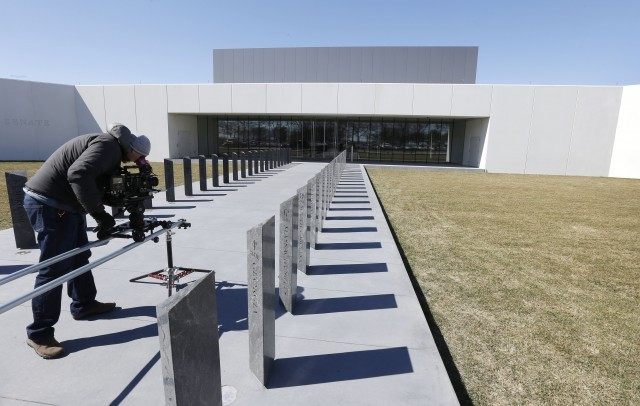Another Ted Kennedy commemoration, another chance for liberals to ignore, dismiss, or outright sneer at the needless death of Mary Jo Kopechne.
Unmentioned in the mainstream media’s usual ululations over Kennedy was what Wikipedia delicately calls the “Chappaquiddick incident.” After leaving a party with Miss Mary Jo Kopechne, a dedicated worker who served during Robert F. Kennedy’s 1968 campaign, Kennedy drove off a bridge and escaped the doomed car, leaving Kopechne behind to die. Also unmentioned: The Edward M. Kennedy Center’s eerie resemblance to an ancient noble’s tomb, where a master is buried with sacrificed underlings.
A quick rundown: On July 18, 1969, Kennedy left a small party with Kopechne. Kennedy later testified he merely planned to drop the pretty, petite blonde off at her hotel room. But Kopechne let no one know she was leaving with him and left her hotel key behind. Kennedy made a wrong turn on the Massachusetts island’s road, and drove off the Dike Bridge into Poucha Pond. Kennedy somehow escaped — perhaps before the car’s engine dragged it down — and swan to shore. Inexplicably, he called Kopechne’s name a few times (because that would help), dived into the pond a few times, then left for his hotel without notifying residents or authorities until after 8 AM the next day after sleeping off the party, well after poor Mary Jo could hope to be rescued.
Kopechne was swiftly buried only a day after she died. A district attorney petitioned to exhume her to determine the cause of death, but his request was denied by a judge — making it impossible to determine whether Kopechne, whose mouth and nose were filled with blood, had drowned quickly or suffocated to death. Both fates are horrible, but Kopechne would have succumbed to suffocation less quickly than drowning, allowing more time for rescuers to save her.
John Farrar, head of the volunteer search and rescue team in Edgartown, reached the scene in 20 minutes the next morning and found Kopechne’s corpse twisted in such a way as to indicate she was searching for pockets of air. Farrar believes she lived for two hours after the crash — not that his testimony would ever go on record.
“I was told outright by the D.A.’s office that I would not be allowed to testify on how long Kopechne was alive in the car,” he told People magazine in July 1989. “They were not interested in the least in anything that would hurt Ted Kennedy.”
Kennedy pled guilty to leaving the scene of an accident causing injury. In sentencing, Judge James Boyle suspended the minimum requirement of two month’s imprisonment, citing Kennedy’s “unblemished record,” effectively wiping out the significance of his victim’s death.
Kennedy suffered no legal consequences beyond a suspended license.
When Kennedy passed away in 2009 after a battle with brain cancer, liberals played down Kopechne’s death:
Kennedy’s “achievements as a senator have towered over his time, changing the lives of far more Americans than remember the name Mary Jo Kopechne,” wrote Kennedy biographer Adam Clymer. As conservative commentator Mark Steyn bitterly remarked while chronicling Kennedy’s eulogies, “You can’t make an omelet without breaking chicks, right?”
Melissa Lafsky called Kopechne the “catalyst” for Kennedy’s political career, since he never served jail time. That “injustice,” Lafsy later wrote, made it possible for Kennedy to keep his Senate seat and run for president.
“It doesn’t automatically make someone (aka, me) a Limbaugh-loving, aerial-wolf-hunting NRA troll what Mary Jo Kopechne would have had to say about Ted’s death, and what she’d have thought of the life and career that are being (rightfully) heralded,” Lafsky wrote in a now-deleted editorial for the Huffington Post. “Who knows — maybe she’d feel it was worth it.”
Author Joyce Carol Oates also weighed Koepechne’s life in the balance and found her death acceptable collateral damage. Obama praised Kennedy for delivering him the Democratic nomination in 2008, which eases the liberal conscience.
“[I]f one weighs the life of a single young woman against the accomplishments of the man President Obama has called the greatest Democratic senator in history, what is one to think?” Oates wrote in an (also deleted) editorial.
Yes, lick a few envelopes, knock on a few doors, then possibly suffocate to death while trapped in a sinking car in the dead of night, drawing shallower and shallower breaths as you bang helplessly on the glass windows as your liberal “lion” leaves you for dead — all in a campaign worker’s abruptly-shortened life, right?
In a callous twist, Obama took it one step further and praised Kennedy’s supposed compassion.
“By the age of 12, he was a member of a Gold Star Family. By 36, two of his brothers were stolen from him in the most tragic, public of ways,” Obama said. “By 41, he nearly lost a beloved child to cancer. And that made suffering something he knew. And it made him more alive to the suffering of others.”
Leaving a woman to die in a submerged car clearly didn’t strike the same notes of empathy in Kennedy. He had bigger things to worry about at the time — like the loud party that stopped him from falling asleep after that exhausting business of driving a car off a bridge.
How do liberals plan to square their “War on Women” rhetoric with their lionization of a man who left woman who dedicated her life — and unwillingly, her death — to Kennedy’s political designs?
One might say they’ll just have to drive off that bridge when they come to it.
Email Katie at kmchugh@breitbart.com.

COMMENTS
Please let us know if you're having issues with commenting.